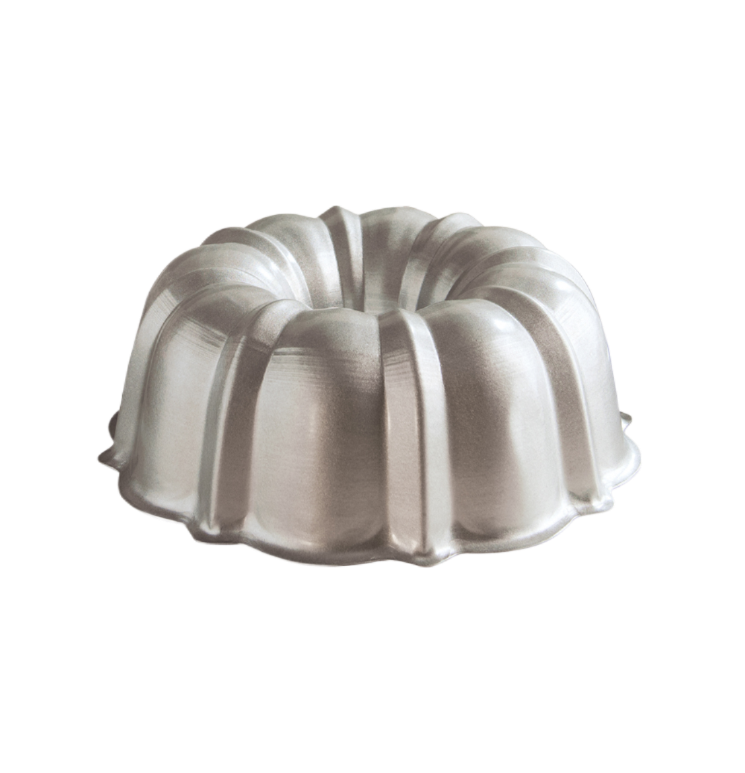The Bundt cake, a beloved dessert known for its distinctive ring shape and moist, rich texture, has a history as intriguing as its design. This culinary icon, which has found a special place in the hearts (and kitchens) of dessert lovers worldwide, has roots that stretch back decades, intertwining with cultural traditions, innovative baking technology, and a dash of serendipity.
European Origins
The story of the Bundt cake begins in the Old World, specifically in the regions of Central and Eastern Europe. Here, dense, rich cakes like the Gugelhupf were popular among Jewish and Christian communities alike. These cakes were typically baked in a distinctive circular mold with a central tube, creating a characteristic ring shape that allowed the cake to cook evenly. The European Gugelhupf, known for its yeast-leavened batter and often filled with nuts, raisins, and spices, laid the groundwork for what would become the modern Bundt cake.
Crossing the Atlantic
As European immigrants made their way to the shores of America, they brought with them their culinary traditions, including the beloved Gugelhupf. However, the transition from Europe to America was not without its challenges. The heavy, dense nature of the traditional Gugelhupf, while cherished, was somewhat at odds with the American palate, which often favored lighter, sweeter cakes.
The Birth of the Bundt
The pivotal moment in the history of the Bundt cake came in the 1950s, thanks to a group of resourceful women from the Hadassah Society in Minneapolis. Seeking to recreate the traditional European cakes of their heritage, they approached a local family-owned cookware company, Nordic Ware, with a request: to create a cast aluminum baking pan that mimicked the ceramic and cast iron molds used in Europe but was better suited to the needs of modern American kitchens.
H. David Dalquist, the founder of Nordic Ware, took on this challenge and designed the first Bundt pan, coining the name "Bundt" by drawing inspiration from the German word "Bund," which means "a gathering of people." The name was not only a nod to the communal aspect of sharing a cake but also a savvy way to trademark the new pan, as "Gugelhupf" was too generic to be protected.
Rise to Popularity
Initially, the Bundt pan didn't take off. It was a novel item, but without the right recipe or cultural moment, it remained a niche product. That all changed in 1966 when a Bundt cake called the "Tunnel of Fudge," baked by Ella Helfrich for the Pillsbury Bake-Off, won second place in the contest. The cake was a sensation, and suddenly, the demand for Bundt pans skyrocketed. Nordic Ware, which had been struggling to sell the pans, found themselves with a hit product. By the late 1960s and into the 1970s, the Bundt cake had become an American staple, synonymous with home baking and family gatherings.
The Bundt Cake Today
Today, the Bundt cake has transcended its humble origins to become a versatile and beloved dessert. The simplicity of the Bundt pan's design, which encourages even baking and a moist crumb, combined with the potential for elaborate decoration and innovative flavors, has ensured the Bundt cake's place in the hearts and kitchens of bakers around the world. From classic recipes handed down through generations to new, adventurous interpretations that incorporate flavors from every corner of the globe, the Bundt cake continues to evolve.
Innovations in pan design have expanded the possibilities for intricate details and patterns, making each cake a work of art. Seasonal flavors, gluten-free and vegan variations, and Bundt cakes featuring exotic spices and ingredients reflect the diverse tastes of modern palates. The Bundt cake has become a canvas for creativity, a symbol of celebration, and a testament to the joy of baking.
Conclusion
The history of the Bundt cake is a testament to the power of innovation, the beauty of tradition, and the enduring appeal of sharing a delicious, beautifully crafted cake with friends and family. From its European origins to its American reinvention and global popularity, the Bundt cake embodies the spirit of culinary exploration and communal enjoyment. It's a reminder that sometimes, the simplest ideas can become the most beloved traditions, enduring through generations and continuing to inspire and delight bakers and cake lovers everywhere. As we slice into the moist, flavorful crumb of a Bundt cake, we're not just indulging in a dessert; we're savoring a piece of history, one delicious bite at a time.

